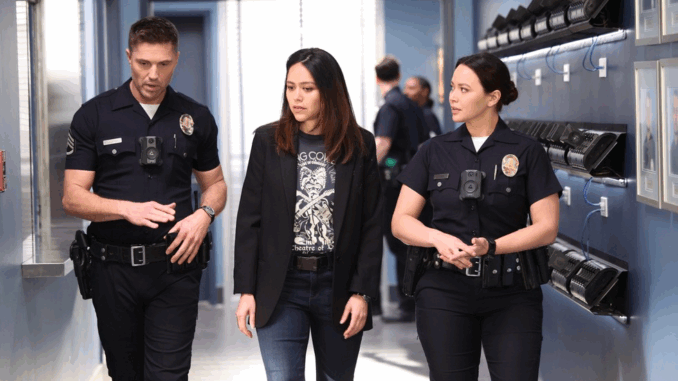
For millions of viewers, ABC’s The Rookie is more than just a police procedural—it’s an inspiring story of reinvention. The series centers on John Nolan, played by Nathan Fillion, a recently divorced Pennsylvania construction company owner who, at the age of 45, uproots his life and moves across the country to become the oldest rookie in the Los Angeles Police Department (LAPD).
Nolan’s journey is launched by a dramatic, life-altering event: surviving a terrifying bank robbery in his small hometown of Foxburg, Pennsylvania. This close brush with mortality is the catalyst that convinces him to pursue a long-dormant dream of becoming a police officer. It’s a compelling, high-stakes origin story that sets the tone for the entire series.
However, what few fans realize is that this seemingly dramatic, made-for-TV premise is actually based on the life of a real-life LAPD officer. The kernel of truth at the heart of John Nolan’s story belongs to a man named William “Bill” Norcross, a career changer who proves that it is truly never too late to start over.
From Fiction to Fact: Meet the Real John Nolan
The basic, most essential elements of John Nolan’s story—leaving a life in Pennsylvania to become an LAPD officer in his mid-forties—are directly inspired by William Norcross.
Norcross, like his fictional counterpart, was in his forties when he decided to fundamentally change his career path and join the LAPD. This decision was pivotal, as the LAPD is one of the few major law enforcement agencies in the United States without a restrictive upper age limit for new recruits, a fact that is explicitly referenced in the show. For both the fictional Nolan and the real Norcross, Los Angeles offered a rare opportunity for a late-in-life “do-over” in a profession typically reserved for younger recruits.
The connection between the show and Norcross is so significant that he is more than just a muse; he is an executive producer on The Rookie. This came about through a college friend, Jon Steinberg, who heard Norcross recount his experiences as the LAPD’s oldest rookie and immediately recognized the powerful, unique concept for a television series.
The Key Differences: Hollywood vs. Reality
While the spirit of John Nolan is undeniably Bill Norcross, the show’s writers took significant creative liberties to build the dramatic backstory audiences see on screen.
The Catalyst: Robbery vs. Realization
In the series, John Nolan’s decision to become a cop is immediate and dramatic. He survives a violent bank robbery and, witnessing the police response, feels a sudden, profound call to service. It is a moment of pure, on-the-spot heroism that pushes him to sell his construction company and enroll in the police academy.
In real life, Bill Norcross’s decision was more of a slow burn—a realization, rather than a reaction. Norcross had always considered a career in law enforcement, but life had taken him down a different path: working in his family’s printing business back in Pennsylvania. As he entered his forties, he had an epiphany. As he explained, he “figured if I was ever going to make a change, that now was the time to do it.” There was no dramatic bank heist, just a determination to pursue a lifelong dream before it was too late.
The Personal Life: Construction vs. Printing, Family vs. Single
The personal lives of John Nolan and William Norcross also diverge significantly:
- Career: Nolan owned a construction company in Pennsylvania, a business he began after his girlfriend became pregnant. Norcross, on the other hand, was entrenched in his family’s digital printing business.
- Family: The fictional John Nolan is a newly divorced father with a college-aged son, Henry. His relationship with his son and the emotional weight of his failed marriage provide much of the early-season drama and emotional depth. In contrast, William Norcross was unmarried and had no children when he made the cross-country move to join the LAPD, a fact that likely made the logistics of the career change less complicated for him than for his fictional counterpart.
These changes were strategic. The show’s creator, Alexi Hawley, infused Nolan’s character with a compelling family narrative and an on-screen romantic life to enrich the drama, leaning into the idea of a man seeking to rebuild his entire life on every front. The heart of the story, however—the “do-over” in the face of age and skepticism—remains firmly rooted in Norcross’s experience.
The Enduring Theme of Reinvention
The true-life inspiration for The Rookie is one of the show’s most powerful takeaways. It transcends the typical cop drama by offering a narrative of second chances. John Nolan, the “oldest rookie,” represents a universal desire to find purpose and meaning, even after a person’s life has seemingly been set in stone.
The reason both the fictional and real journeys culminate in Los Angeles is a pragmatic one, tied to those age limits. Norcross actively sought out the LAPD because they had no upper age restriction, coupled with an expedited testing process. This detail grounds the dramatic move in a logistical reality, highlighting the effort and research required to chase a dream that most other cities would deny on the basis of age alone.
The Legacy of the Real Rookie
William Norcross didn’t just inspire the show; he remains an active member of the LAPD, having been promoted to Sergeant. His success validates the premise of the series—that experience, maturity, and a passion for service can be just as valuable as youth in law enforcement.
While viewers may not see a bank robbery in Norcross’s past, the emotional core of his decision perfectly mirrors the spirit of John Nolan: the moment a person in their forties looks at their life and realizes they must take a leap of faith to pursue their true calling. The Rookie transforms this quiet, personal determination into a heroic, on-screen saga, ensuring the real-life story of the LAPD’s oldest rookie continues to inspire millions to believe that it’s never too late for a fresh start.
